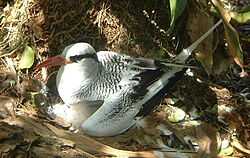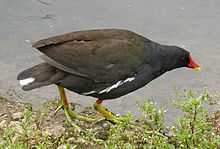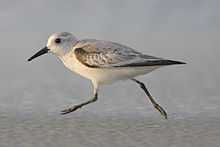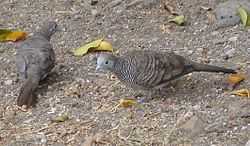List of birds of Saint Helena
.jpg)
This is a list of the bird species recorded on Saint Helena. The avifauna of Saint Helena Island include a total of 68 species. Only one endemic species survives today, the Saint Helena plover. Several more endemics are extinct and known only from subfossil remains: the Saint Helena petrel, Olson's petrel, Saint Helena shearwater, Saint Helena crake, Saint Helena swamphen, Saint Helena dove, Saint Helena cuckoo and Saint Helena hoopoe. At least five non-endemics have been extirpated from Saint Helena but still occur elsewhere. Nine species have been introduced by humans and formed established breeding populations while many more species were introduced in the past but failed to become established. Of these, 43 species are rare or accidental visitors.
This list's taxonomic treatment (designation and sequence of orders, families and species) and nomenclature (common and scientific names) follow the conventions of The Clements Checklist of Birds of the World, 6th edition. The family accounts at the beginning of each heading reflect this taxonomy, as do the species counts found in each family account. Introduced and accidental species are included in the total counts for Saint Helena.
The following tags have been used to highlight several categories, but not all species fall into one of these categories. Those that do not are commonly occurring native species.
- (A) Accidental - a species that rarely or accidentally occurs in Saint Helena
- (E) Endemic - a species endemic to Saint Helena
- (I) Introduced - a species introduced to Saint Helena as a consequence, direct or indirect, of human actions
- (Ex) Extirpated - a species that no longer breeds in Saint Helena although populations exist elsewhere
| Table of contents |
|---|
|
Non-passerines: Albatrosses • Shearwaters and petrels • Storm petrels • Tropicbirds • Boobies and gannets • Frigatebirds • Herons and egrets • Storks • Falcons • Pheasants and partridges • Rails, crakes and gallinules • Plovers and lapwings • Sandpipers and allies • Sheathbills • Skuas and jaegers • Terns • Pigeons and doves |
|
Passerines: Swallows and martins • Starlings • Weavers and allies • Waxbills and allies • Finches |
Albatrosses
Order: Procellariiformes Family: Diomedeidae
The albatrosses are among the largest of flying birds, and the great albatrosses from the genus Diomedea have the largest wingspans of any extant birds.
- Wandering albatross, Diomedea exulans (A)
- Black-browed albatross, Thalassarche melanophris (A)
- Yellow-nosed albatross, Thalassarche chlororhynchos (A)
- Sooty albatross, Phoebetria fusca (A)
Shearwaters and petrels

Order: Procellariiformes Family: Procellariidae
The procellariids are the main group of medium-sized "true petrels", characterised by united nostrils with medium septum and a long outer functional primary.
- Antarctic giant petrel, Macronectes giganteus (A)
- Southern fulmar, Fulmarus glacialoides (A)
- Cape petrel, Daption capense (A)
- Murphy's petrel, Pterodroma ultima (A)
- Soft-plumaged petrel, Pterodroma mollis (A)
- Broad-billed prion, Pachyptila vittata (A)
- Bulwer's petrel, Bulweria bulwerii
- White-chinned petrel, Procellaria aequinoctialis (A)
- Cory's shearwater, Calonectris diomedea (A)
- Sooty shearwater, Puffinus griseus (A)
- Audubon's shearwater, Puffinus lherminieri (Ex, A)
Storm petrels

Order: Procellariiformes Family: Hydrobatidae
The storm petrels are relatives of the petrels and are the smallest seabirds. They feed on planktonic crustaceans and small fish picked from the surface, typically while hovering. The flight is fluttering and sometimes bat-like.
- Wilson's storm petrel, Oceanites oceanicus (A)
- White-faced storm petrel, Pelagodroma marina (Ex, A)
- Black-bellied storm petrel, Fregetta tropica (A)
- White-bellied storm petrel, Fregetta grallaria (A)
- Band-rumped storm petrel, Oceanodroma castro
- Leach's storm petrel, Oceanodroma leucorhoa (A)
Tropicbirds

Order: Pelecaniformes Family: Phaethontidae
Tropicbirds are slender white birds of tropical oceans, with exceptionally long central tail feathers. Their heads and long wings have black markings.
- Red-billed tropicbird, Phaethon aethereus
Boobies and gannets
Order: Pelecaniformes Family: Sulidae
The sulids comprise the gannets and boobies. Both groups are medium to large coastal seabirds that plunge-dive for fish.
- Masked booby, Sula dactylatra
- Red-footed booby, Sula sula (Ex, A)
- Brown booby, Sula leucogaster
Frigatebirds
Order: Pelecaniformes Family: Fregatidae
Frigatebirds are large seabirds usually found over tropical oceans. They are large, black and white or completely black, with long wings and deeply forked tails. The males have coloured inflatable throat pouches. They do not swim or walk and cannot take off from a flat surface. Having the largest wingspan-to-body-weight ratio of any bird, they are essentially aerial, able to stay aloft for more than a week.
- Great frigatebird, Fregata minor (Ex)
- Lesser frigatebird, Fregata ariel (Ex)
Herons and egrets
_-Florida_Keys2.jpg)
Order: Ciconiiformes Family: Ardeidae
The family Ardeidae contains the bitterns, herons and egrets. Herons and egrets are medium to large wading birds with long necks and legs. Bitterns tend to be shorter necked and more wary. Members of Ardeidae fly with their necks retracted, unlike other long-necked birds such as storks, ibises and spoonbills.
- Grey heron, Ardea cinerea (A)
- Cattle egret, Bubulcus ibis
- Black-crowned night heron, Nycticorax nycticorax (A)
Storks
Order: Ciconiiformes Family: Ciconiidae
Storks are large, long-legged, long-necked, wading birds with long, stout bills. Storks are mute, but bill-clattering is an important mode of communication at the nest. Their nests can be large and may be reused for many years. Many species are migratory.
- White stork, Ciconia ciconia (A)
Falcons
Order: Falconiformes Family: Falconidae
Falconidae is a family of diurnal birds of prey. They differ from hawks, eagles and kites in that they kill with their beaks instead of their talons.
- Amur falcon, Falco amurensis (A)
Pheasants and partridges

Order: Galliformes Family: Phasianidae
The Phasianidae are a family of terrestrial birds which consists of quails, partridges, snowcocks, francolins, spurfowls, tragopans, monals, pheasants, peafowls and jungle fowls. In general, they are plump (although they vary in size) and have broad, relatively short wings.
- Chukar, Alectoris chukar (I)
- Ring-necked pheasant, Phasianus colchicus (I)
Rails, crakes and gallinules

Order: Gruiformes Family: Rallidae
Rallidae is a large family of small to medium-sized birds which includes the rails, crakes, coots and gallinules. Typically they inhabit dense vegetation in damp environments near lakes, swamps or rivers. In general they are shy and secretive birds, making them difficult to observe. Most species have strong legs and long toes which are well adapted to soft uneven surfaces. They tend to have short, rounded wings and to be weak fliers.
- Purple swamphen, Porphyrio porphyrio (A)
- Allen's gallinule, Porphyrio alleni (A)
- Purple gallinule, Porphyrio martinica (A)
- Common moorhen, Gallinula chloropus
Plovers and lapwings
Order: Charadriiformes Family: Charadriidae
The family Charadriidae includes the plovers, dotterels and lapwings. They are small to medium-sized birds with compact bodies, short, thick necks and long, usually pointed, wings. They are found in open country worldwide, mostly in habitats near water.
- Blacksmith plover, Vanellus armatus (A)
- American golden plover, Pluvialis dominica (A)
- Black-bellied plover, Pluvialis squatarola (A)
- Saint Helena plover (known locally as the wirebird), Charadrius sanctaehelenae (E)
Sandpipers and allies

Order: Charadriiformes Family: Scolopacidae
Scolopacidae is a large diverse family of small to medium-sized shorebirds including the sandpipers, curlews, godwits, shanks, tattlers, woodcocks, snipes, dowitchers and phalaropes. The majority of these species eat small invertebrates picked out of the mud or soil. Variation in length of legs and bills enables multiple species to feed in the same habitat, particularly on the coast, without direct competition for food.
- Green sandpiper, Tringa ochropus (A)
- Ruddy turnstone, Arenaria interpres (A)
- Red knot, Calidris canutus (A)
- Sanderling, Calidris alba (A)
- White-rumped sandpiper, Calidris fuscicollis (A)
- Pectoral sandpiper, Calidris melanotos (A)
- Ruff, Philomachus pugnax (A)
Sheathbills
Order: Charadriiformes Family: Chionididae
The sheathbills are scavengers of the Antarctic regions. They have white plumage and look plump and dove-like but are believed to be similar to the ancestors of the modern gulls and terns.
- Snowy sheathbill, Chionis alba (A)
Skuas and jaegers

Order: Charadriiformes Family: Stercorariidae
The family Stercorariidae are, in general, medium to large birds, typically with grey or brown plumage, often with white markings on the wings. They nest on the ground in temperate and arctic regions and are long-distance migrants.
- Brown skua, Stercorarius antarctica (A)
- Pomarine jaeger, Stercorarius pomarinus
- Parasitic jaeger, Stercorarius parasiticus
- Long-tailed jaeger, Stercorarius longicaudus (A)
Terns

Order: Charadriiformes Family: Sternidae
Terns are a group of generally medium to large seabirds typically with grey or white plumage, often with black markings on the head. Most terns hunt fish by diving but some pick insects off the surface of fresh water. Terns are generally long-lived birds, with several species known to live in excess of 30 years.
- Brown noddy, Anous stolidus
- Black noddy, Anous minutus
- White tern, Gygis alba
- Sooty tern, Onychoprion fuscatus
- Antarctic tern, Sterna vittata (A)
- Arctic tern, Sterna paradisaea (A)
Pigeons and doves

Order: Columbiformes Family: Columbidae
Pigeons and doves are stout-bodied birds with short necks and short slender bills with a fleshy cere.
- Rock pigeon, Columba livia (I)
- Zebra dove, Geopelia striata (I)
Swallows and martins
Order: Passeriformes Family: Hirundinidae
The Hirundinidae family is adapted to aerial feeding. They have a slender streamlined body, long pointed wings and a short bill with a wide gape. The feet are adapted to perching rather than walking, and the front toes are partially joined at the base.
- Barn swallow, Hirundo rustica (A)
Starlings
_on_Kapok_(Ceiba_pentandra)_in_Kolkata_W_IMG_4297.jpg)
Order: Passeriformes Family: Sturnidae
Starlings are small to medium-sized passerine birds. Their flight is strong and direct and they are very gregarious. Their preferred habitat is fairly open country. They eat insects and fruit. Plumage is typically dark with a metallic sheen.
- Common myna, Acridotheres tristis (I)
Weavers and allies

Order: Passeriformes Family: Ploceidae
The weavers are small passerine birds related to the finches. They are seed-eating birds with rounded conical bills. The males of many species are brightly coloured, usually in red or yellow and black, some species show variation in colour only in the breeding season.
- Red fody, Foudia madagascariensis (I)
Waxbills and allies
Order: Passeriformes Family: Estrildidae
The estrildid finches are small passerine birds of the Old World tropics and Australasia. They are gregarious and often colonial seed eaters with short thick but pointed bills. They are all similar in structure and habits, but have wide variation in plumage colours and patterns.
- Common waxbill, Estrilda astrild (I)
- Java sparrow, Padda oryzivora (I)
Finches
Order: Passeriformes Family: Fringillidae
Finches are seed-eating passerine birds, that are small to moderately large and have a strong beak, usually conical and in some species very large. All have twelve tail feathers and nine primaries. These birds have a bouncing flight with alternating bouts of flapping and gliding on closed wings, and most sing well.
- Yellow canary, Serinus flaviventris (I)
See also
References
- African Bird Club (2008). "Saint Helena". Retrieved 1 October 2008.
- Clements, James F. (2007). The Clements Checklist of Birds of the World. Cornell University Press. ISBN 978-0-8014-4501-9.
- McCulloch, Neil (2004). A guide to the birds of St Helena and Ascension Island. RSPB. ISBN 978-1-901930-46-7.
| ||||||||||||||